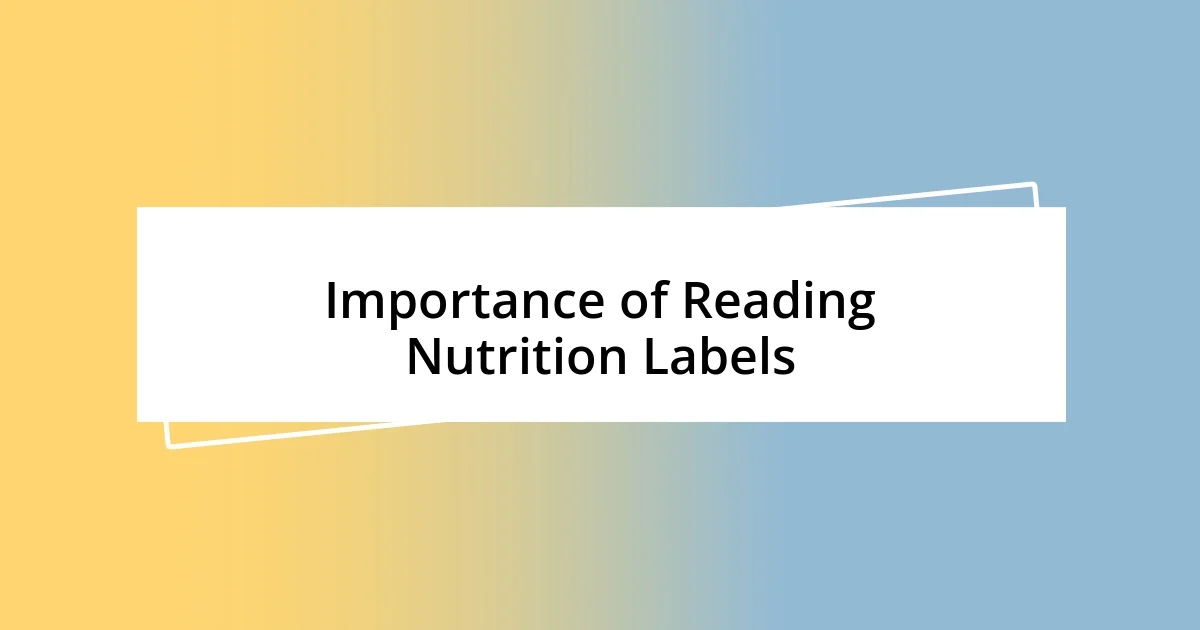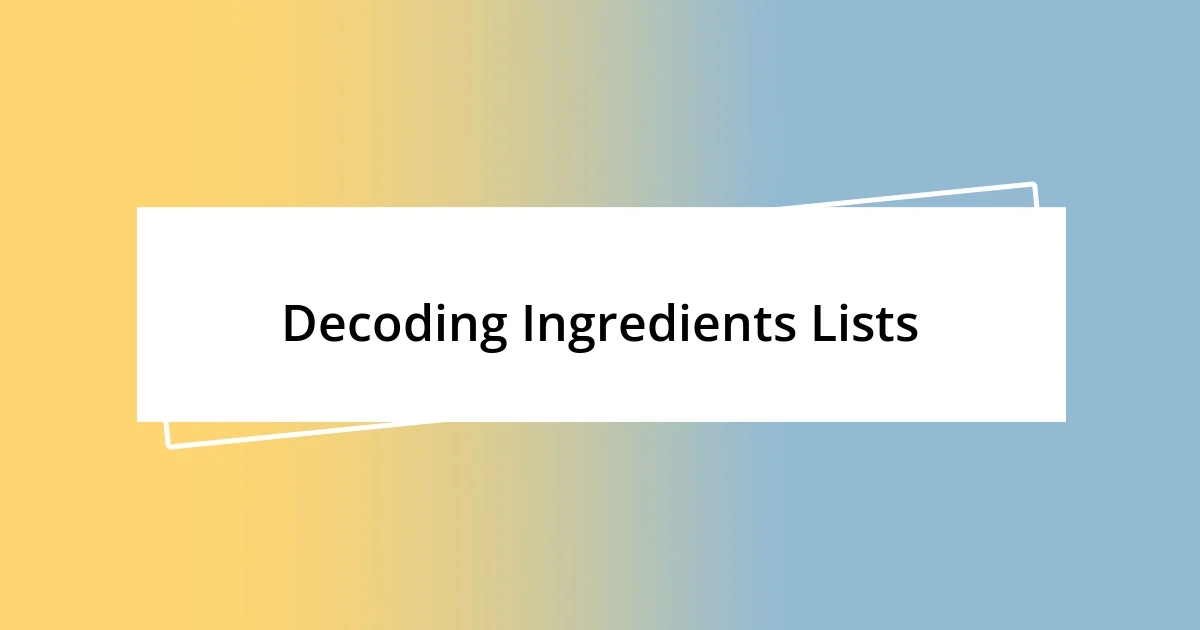Key takeaways:
- Understanding serving sizes is crucial for portion control and preventing unintentional overeating.
- Reading the ingredients list helps identify healthful choices and avoid unnecessary additives, with an emphasis on familiar ingredients.
- Critically evaluating nutritional claims empowers consumers to make informed choices and prioritize whole foods over processed options.

Understanding Nutrition Labels
When I first stared at a nutrition label, I felt overwhelmed. All those numbers and terms left me questioning if I was even up for the challenge. But here’s a key insight: the most important part is the serving size. It sets the standard for everything else on the label. Have you ever eaten a snack only to realize you consumed double the calories? It’s a common mistake, and understanding serving size can prevent that pitfall.
As I delved deeper into reading labels, I learned to focus on the percentage of daily values. It’s like a roadmap that guides you through your dietary choices. I remember feeling a sense of empowerment the first time I spotted a food item that boasted a high percentage of fiber. It was a little victory that made grocery shopping more exciting and purposeful. When was the last time a simple label led you to a healthier choice?
Ultimately, the ingredients list became my ultimate guide as I began to discern between healthful and processed foods. I still recall the squeamish feeling when I discovered how many additives lurked in my favorite snacks. It made me question what I really wanted to fuel my body with. Reading labels isn’t just about numbers; it’s a pathway to understanding what I put in my body, making every bite feel intentional and informed.

Importance of Reading Nutrition Labels
Understanding the importance of reading nutrition labels truly transformed the way I view food. It’s not just about calories; it’s about knowing what I’m ingesting. I remember a time when I mindlessly grabbed a cereal box, only to find out that the first ingredient was sugar. That moment was a wake-up call, teaching me that knowledge is power.
Here are some key reasons why reading nutrition labels is essential:
- Informed Choices: Knowing the ingredients allows me to select healthier options and avoid unwanted additives.
- Tracking Nutrients: Monitoring daily values of vitamins and minerals helps me meet my dietary needs.
- Portion Control: Understanding serving sizes prevents me from overeating without even noticing.
- Managing Conditions: For those with allergies or specific dietary needs, labels can be lifesavers.
- Mindful Eating: Reading labels cultivates a deeper connection to the food I consume, fostering intentional choices.
Every time I pick up a product, I feel a surge of confidence knowing I’m taking charge of my health, turning shopping into an adventure rather than a chore.

Key Components of Nutrition Labels
When I examine a nutrition label, I first hone in on the calorie count. It’s fascinating how a seemingly innocuous snack can pack a punch! I remember the first time I realized that a single granola bar I enjoyed had nearly 300 calories. That eye-opening moment forced me to rethink my snack choices. For me, it’s not just about the number; it’s about understanding how that number fits into my daily caloric needs. Have you ever been caught off guard by a snack’s calorie content? Trust me, knowing this can make a world of difference in how you plan your meals.
Another essential component is the nutrient breakdown, including fats, carbohydrates, and proteins. These values guide me toward balanced eating. I clearly recall switching to a yogurt packed with protein that kept me full longer. It illuminated how a small change could have lasting impacts on my energy levels. Understanding how these macronutrients work together helps me make savvy choices that fuel my day effectively. What highlights have you enjoyed on your nutrition journey?
The ingredients list often reveals surprising insights about the foods I consume. The first time I scanned a label and found words I couldn’t pronounce, it raised red flags for me. It’s like detective work; I want to ensure I’m not consuming unnecessary fillers or preservatives. I appreciate what goes into my food, so I aim for items with recognizable ingredients that reflect healthful choices. How often do you scrutinize your ingredients list?
| Component | Key Insight |
|---|---|
| Serving Size | Sets the baseline for all nutritional information. |
| Calories | Critical for managing energy intake. |
| Nutrients | Focus on protein, fats, and carbohydrates for balanced meals. |
| Ingredients List | Reflects the quality of the food; look for recognizable items. |

How to Interpret Serving Sizes
Understanding serving sizes can be a game-changer in your journey toward healthier eating. The first time I really grasped this concept, I was at a family gathering with a buffet spread. I filled my plate haphazardly, only to realize later that portions were significantly larger than what I typically eat at home. This insight opened my eyes to the importance of referencing the serving size on the nutrition label, which sets a standard for what a single serving truly looks like.
When I learned that the serving size listed isn’t necessarily what you’d think, it created a sense of urgency in me to pay attention. For example, that bag of chips I loved? The serving size was just a handful! I remember measuring it out and being shocked by how quickly I could blow past that number without even realizing it. It made me wonder how many calories I was consuming unknowingly, forcing me to reconsider my snacking habits. Have you ever thought you were being moderate, only to discover that your idea of a portion was wildly off?
Now, I always use serving sizes not just as a guideline, but as a benchmark for mindful eating. I encourage you to keep a measuring cup handy when trying out new foods. It may seem tedious at first, but the clarity it brings is worth it. Trust me, converting snacks into more manageable portions has helped me maintain control over my diet and feel more energetic throughout the day. Remember, it’s not just about cutting back—it’s about being conscious of how much you’re really eating.

Decoding Ingredients Lists
Deciphering the ingredients list can feel like unraveling a mystery. I still remember my initial struggle with some of the terms—it felt as if I needed a translation guide! My turning point came when I started jotting down unfamiliar terms and looking them up later. That simple practice transformed my approach. Now, I can spot red flags like high-fructose corn syrup or excessive artificial flavors in a matter of seconds. Have you ever felt overwhelmed by jargon on a label? It makes a difference to take the time to understand what goes into your food.
Focusing on the order of ingredients gives me greater insight into a product’s quality. The rule of thumb is that ingredients are listed in descending order by weight. If sugar or refined grains dominate that list, I know I should tread carefully. One afternoon, I was about to grab a popular snack. Checking the list revealed that it was primarily sugar—a quick second glance changed my mind completely. Instead, I opted for a more whole-food-based option. Have you experienced that little thrill when you uncover a hidden truth within a label?
I find great satisfaction in choosing products with familiar and wholesome ingredients. When I discover foods crafted with real, simple ingredients, it feels like I’m making a more authentic choice for my health. For instance, I recently switched to granola made from oats, nuts, and dried fruits instead of processed varieties filled with unrecognizable additives. Each bite feels so much more nourishing. So, how often do you pause to consider what’s actually in your food? Knowing what you’re eating is empowering, and I encourage you to embrace that power!

Understanding Nutritional Claims
Understanding nutritional claims is essential for making informed food choices. I vividly recall my initial excitement when I stumbled upon claims like “low-fat” or “heart-healthy.” It felt like I had found secret codes that would lead me to healthier options. However, I soon realized that these terms can be misleading. For instance, something labeled as “low-fat” might have a higher sugar content to compensate for flavor, leaving me wondering if it was truly healthier. Have you ever been swayed by a claim only to feel misled later?
It’s important to dig deeper into what these claims actually mean. I remember a time when I bought yogurt advertised as “light,” thinking I was making a smart choice. Upon closer inspection, I discovered that it contained artificial sweeteners that I’d rather avoid. It made me think about how companies often play with language to market their products. Understanding these nuances allows me to navigate the grocery store with more confidence. Have you ever felt uncertain about what a label really meant?
I’ve learned that whole foods tend to speak for themselves. Instead of relying on claims plastered on packaging, I focus on natural foods without the marketing fluff. When I switched to plain yogurt and added my own fruit, I felt empowered to control what went into my diet. It’s liberating to know that I’m prioritizing real nutrition over clever marketing. So, when was the last time you evaluated a product’s claims critically? The next time you’re tempted by a tempting label, take a moment to investigate. You might just find that the simplest choices are often the most nourishing.

Practical Tips for Reading Labels
When I first started to read nutrition labels, I found it helpful to focus on serving sizes. It’s surprising how a seemingly casual snack can consist of multiple servings, leading to unintentional overindulgence. Once, I grabbed a bag of chips that I thought was a single serving, only to discover later that it contained three! That realization changed my snacking habits for good. How often do we actually pay attention to the serving size?
I also recommend looking for the % Daily Value (DV) section. It gives insight into how much a particular nutrient contributes to your daily diet based on a standard of 2,000 calories. For instance, if I see a product with 20% DV for sodium, I know I need to balance that food choice with lower sodium meals throughout the day. Just the other day, I checked a frozen meal and was shocked to see it packed with more than half of my daily sodium limit! Doesn’t it feel reassuring to know exactly where you stand with your daily nutrient intake?
Another tip that really transformed my understanding is checking for added sugars. I used to breeze past this area without a second thought. But when I started comparing labels, I noticed some brands sneaking in excessive sugar while advertising themselves as healthy. I remember being frustrated with a breakfast bar I thought was wholesome until I saw it had more sugar than a candy bar! Now, I actively seek out products with little to no added sugar. Have you ever had a wake-up call like that? It’s truly eye-opening!














